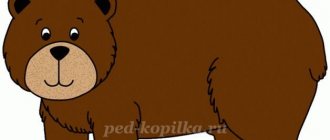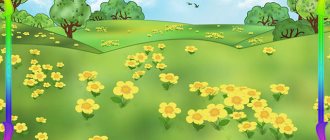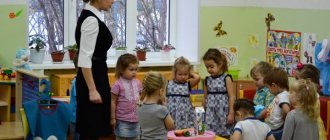Lesson summary for the 2nd junior group “Big-Small”, prepared by V.V. Shevchenko.
Topic: “Big - small. One, many, none. Grouping by color"
Goal : To teach children to combine identical (by color, size) objects into object sets according to a verbal task.
Continue to teach how to identify one object from many, answer the question “how many”? in words one, many, none.
Materials: soft toy Bunny. Demonstration cubes: large, small for the teacher and two cubes - large, small for each child, large and small box, red, blue, green and yellow plates, one piece per child. Circles of four colors: red, blue, yellow and green. One black circle for each table. Carrots according to the number of children.
Progress of the lesson.
- Motivational-orientation stage
-A forest animal decided to visit us today. Try to guess who came to us. He has long ears and a small tail. He loves to jump and loves to chew carrots.
-This is a bunny.
-Right! Our bunny loves to play and build towers: high and low. But I haven’t learned how to collect toys yet. And you and I are already big children, we have learned to play and put toys in their places. Let's help our bunny put the cubes into boxes.
- Search stage
The game is the task “Put the cubes into boxes.”
Cubes are laid out in front of the child: large and small for each child. Two boxes have been prepared: large and small.
-The bunny brought cubes for each of you and asks you to put them in boxes: large cubes in a large box, and small cubes in a small box.
-Look, what kind of box is this? (large).
-What is this box? (small).
Look at your cubes. Show me a big cube (show). Show me the small one (show).
On the teacher’s table there are demonstration cubes: large and small. The teacher is the first to lay out the boxes, accompanying the actions with speech.
-Look, I will put a large cube in a large box, and a small cube in a small box.
(children complete the task after the teacher explains).
.-So we helped Bunny: we put the big cubes in a large box, and the small ones in a small box. The bunny is happy, he smiles:
-How many cubes are in the boxes? (a lot of)
-How many cubes do you have? (no one).
3.Practical stage
Plates are laid out on the table. Each child has his own plate of a certain color: blue, red, yellow and green. In the center of the table there are multi-colored circles of red, yellow, blue, green and one black. Children should put circles in their plate that are the same color as the plate itself.
-Look at the colorful plates the Bunny brought for you. The Bunny also brought colorful circles and asks to put them on plates. What color is the plate, the same color of circles should be placed in it. Put red circles in a red plate, blue circles in a blue plate, green circles in a green plate, and yellow circles in a yellow plate.
Each child places the circles on their own plate (children complete the task independently). There should be a black circle left on the table.
- Said, what color are the circles in your plate? (blue). How many are there? (a lot of).
-Look, there is a circle left on the table. What colour is he? (black).
— How many black circles are left on the table? (one).
Physical exercise "Loud - quiet."
-Let's rest a little. Let's play the game "Loud - Quiet." When I play the tambourine loudly, loudly, you will jump like bunnies. And if I start ringing the bell quietly and quietly, you hide (squat down).
The game can be complicated by playing musical instruments without showing the children, giving them the opportunity to guess by ear.
Game-task “How many carrots”.
Carrots are displayed on the board according to the number of children.
-Our Bunny is so hardworking. He carefully prepared for winter. What do bunnies like to eat?
-Carrot.
- Right. How many carrots are there on the board? (a lot of).
-Come up and take one carrot at a time (children come up and take a carrot).
-How many carrots do you have, Artem? (one).
-How many carrots did you take? (one by one).
-Now put them on the table again. How many carrots do you have, Zhenya? (none).
-How many carrots are there on the board? (a lot of).
- 3. Reflective-evaluative stage
-It's time to say goodbye to our guest. Where does Bunny live, guys?
-In the forest.
-That's right, did you like playing with the Bunny? And he really liked you. He says that you are great! He promises that he will come visit us again soon. Goodbye, guys!
Summary of OD in 1st junior group. Large and small cubes
Summary of educational activities on sensory development in the 1st junior group on the topic “Big and small cubes”
Author: Chernikova Dina Nikolaevna, teacher of MBDOU kindergarten No. 1 in the village of Staroye Melkovo, Tver region, Konakovsky district. Description of the material: I offer you a summary of educational activities for children of the 1st junior group (2-3 years old) on sensory development on the topic “Big and small cubes.”
This material will be useful to teachers of the younger group. This is a summary of an educational lesson aimed at understanding and using the concepts in speech: big, small, the same, identical in size. Summary of educational activities on sensory development in 1st junior group
Topic “Big and small cubes”
Goal: understand and use in speech the concepts: large, small, the same, identical in size. Objectives: Educational:
- sort objects of two sharply different sizes;
- teach to understand and use the concepts in speech: big, small, the same, identical in size; — consolidate the concept of one – many. Developmental:
- develop the ability to compare objects by size using the method of visual correlation.
Educational:
- cultivate curiosity, cognitive interest, kindness.
Vocabulary work: big, small, the same, identical in size, one, many. Methodological techniques: surprise moment, problem situation, examination of objects, conversation-dialogue, productive activity of children, analysis, summing up. Material: toys - a bear, two cars (large, small); multi-colored cubes that vary sharply in size; large and small buckets. OD progress: I. Introductory part. 1. Surprise moment. Educator: Guys, someone came to visit us! But to find out who it is, you need to guess the riddle: “Ballfooted and big, He sleeps in a den in winter. He loves pine cones, he loves honey, Well, who’s going to name it?” Children: Bear. II. Main part. 1. Problem situation. Educator: That's right, guys, look, and here is the bear, but he doesn't have empty paws, he's carrying something in the car. What is this? Children: Cubes. Educator: That's right, but why, let's ask? (Children ask the bear) Bear: I wanted to build a house out of cubes for bear cubs: for big bear cubs from large cubes, for small ones from small cubes, but suddenly the bunnies came running and mixed all the cubes, and now I can’t take them apart and I’m so sad . Educator: Don’t be sad, bear, we will help you, right, guys? Children's answers. Educator: We will sort out the cubes and help you, let's bring your truck here. And so that you don’t feel sad, play with us. 2. Physical education. The bear cubs often lived there, twisting their heads, Like this, like this, (Circular movements of the head to the right and left) They twisted their heads. The cubs were looking for honey, They rocked the tree together, Like this, like this, (Springy flexion and extension of the arms) Together they rocked the tree. They waddled (steps in place, swaying from side to side) and drank water from the river. Like this, like this, (Bends forward, hands down) And they drank water from the river. And then they danced, (Squatting. Jumping on one leg) Raising their paws to the sun. Like this, like this, (Arms forward, up, to the sides, down) They raised their paws towards the sun. 3. Perform the task one by one. Educator: Guys, I have two buckets like these. Show me the big bucket. Show me the small bucket. (Children show). Educator: We will put large cubes in a large bucket, and small cubes in a small bucket. Take one or two cubes each. Compare the small cube with the large one. (The teacher uses words for comparison: big, small, the same, identical in size). Educator: Place them side by side, then put them in the right bucket. (Children put the cubes into buckets of the appropriate size.) Educator: Well done, guys! How many cubes are there in a large bucket? Children: A lot. Educator: How many cubes are there in the small bucket? Children: A lot. Educator: Well, bear, how did we cope with the task? Bear: Thank you guys for your help, you helped me sort out the cubes. III. Final part. Educator: Guys, the bear cubs are probably tired of waiting for the bear, we need to take him home, but as soon as he gets the cubes, they might get mixed up again. Answers-assumptions of children . Educator: Look, guys, I also have a car. What is she like? Big or small? Children: Little. Educator: That's right, little one, what cubes should we put there? Children: Little ones. Educator: That's right, little ones. What about the big one? Children: Big ones. Educator: Let's help the bear sort the cubes into the cars. (Children lay out the cubes and say goodbye to the bear).
We recommend watching:
Notes for a lesson on sensory development in the 1st junior group. Notes for a lesson on speech development in the 1st junior group. group Notes of a complex lesson in junior group I Notes of educational activities in the early age group
Similar articles:
Summary of GCD in the 1st junior group by February 23




